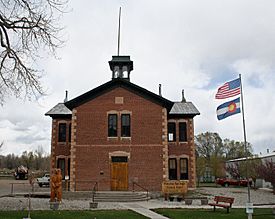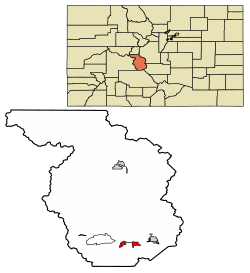Poncha Springs, Colorado facts for kids
Quick facts for kids
Town of Poncha Springs, Colorado
|
|
|---|---|

The Poncha Springs Town Hall, formerly a school
|
|
| Nickname(s):
Crossroads of the Rockies
|
|

Location of Poncha Springs in Chaffee County, Colorado.
|
|
| Country | |
| State | |
| County | Chaffee |
| Incorporated (town) | December 16, 1880 |
| Government | |
| • Type | Statutory Town |
| Area | |
| • Total | 2.98 sq mi (7.73 km2) |
| • Land | 2.98 sq mi (7.73 km2) |
| • Water | 0.00 sq mi (0.00 km2) |
| Elevation | 7,477 ft (2,279 m) |
| Population
(2024)
|
|
| • Total | 1,406 |
| • Density | 471.8/sq mi (181.89/km2) |
| Time zone | UTC-7 (Mountain (MST)) |
| • Summer (DST) | UTC-6 (MDT) |
| ZIP code |
81242 (PO Box)
|
| Area code(s) | 719 |
| FIPS code | 08-60600 |
| GNIS feature ID | 2412495 |
Poncha Springs is a small town in Chaffee County, Colorado, United States. It is known as a "statutory town," which means it follows specific state laws for how it is run. In 2020, about 925 people lived there. By 2024, the population grew to 1,406 people.
Contents
The Story of Poncha Springs
Early Days and First Settlers
Long ago, the Ute people used the Poncha Springs area as a winter camping spot. In 1779, a Spanish explorer named Juan Bautista de Anza led a military trip over Poncha Pass, which is about 6 miles south of where the town is now. After the Spanish, French trappers and fur traders came to the area.
In 1855, Colonel Thomas T. Fauntleroy and his soldiers marched over Poncha Pass. They had a battle with a group of Utes between what is now Salida and Poncha Springs. This was part of the Ute Wars.
Around 1860, people looking for gold and other valuable minerals, called prospectors, started to arrive. Bob Hendricks and Nat Rich built the first cabin in town, which you can still see today. Nat Rich's son, James, was the first white child born in Poncha Springs in 1867. That same year, Poncha Springs became an official election area.
Growing into a Town
An Indian agent named John Burnett and his wife, Minerva Maxwell Burnett, settled here. Minerva was one of the first schoolteachers in Poncha Springs. In 1866, John Burnett built a log building on his ranch. It was used as a trading post for Native Americans. Other families, like the Hutchinsons and McPhersons, also settled in the area around this time. John McPherson bought land from Nat Rich and built a grocery store.
Poncha Springs started to grow a lot in the 1870s. It officially became a town on December 8, 1880. The Poncha Springs Schoolhouse was finished in 1883. This building is very old and important, so it is listed on the National Register of Historic Places. It used to be the town hall. In 2017, the town built a new town hall next to the old schoolhouse. The old schoolhouse is now used as the Ark Valley Preschool.
The Famous Hot Springs
Discovery and Early Use
People disagree about who first found the hot springs in Poncha Springs. Some historians think it was Lt. Zebulon Pike in 1806. He is the person Pikes Peak is named after. Others believe it was a frontiersman named Kit Carson, who traveled through Poncha Springs in 1832.
In 1868, John Burnett, Henry Weber, and Paul Irvine built the first bath fed by the springs. They dug a large pit and lined it with logs to hold the water. When the railroad came through, the town became very popular. The hot springs were a big attraction. Two hotels were built at the springs, but both burned down.
Managing the Springs
In 1904, after the last fire, the Holman family arrived to manage the springs. By then, there was a rock pool, two cabins, two baths, and a sleeping room.
Donald Hartwich operated the springs from 1927 to 1935. After that, the City of Salida piped the water from the springs to their public pool in Salida. The original springs were then covered with cement. They are now owned by the City of Salida.
Where is Poncha Springs?
The town of Poncha Springs covers an area of about 2.98 square miles of land. It is located in a beautiful part of Colorado.
How Many People Live Here?
| Historical population | |||
|---|---|---|---|
| Census | Pop. | %± | |
| 1880 | 170 | — | |
| 1890 | 101 | −40.6% | |
| 1900 | 97 | −4.0% | |
| 1910 | 43 | −55.7% | |
| 1920 | 37 | −14.0% | |
| 1930 | 80 | 116.2% | |
| 1940 | 94 | 17.5% | |
| 1950 | 114 | 21.3% | |
| 1960 | 201 | 76.3% | |
| 1970 | 198 | −1.5% | |
| 1980 | 321 | 62.1% | |
| 1990 | 244 | −24.0% | |
| 2000 | 466 | 91.0% | |
| 2010 | 737 | 58.2% | |
| 2020 | 925 | 25.5% | |
| U.S. Decennial Census | |||
The table above shows how the population of Poncha Springs has changed over many years. You can see that the number of people living in the town has grown quite a bit, especially in recent decades.
Getting Around Poncha Springs
Poncha Springs calls itself the "Crossroads of the Rockies." This is because two important highways meet in the town. US 50 goes through the town from east to west. US 285 runs through the town from north to south.
Poncha Springs is also part of Colorado's Bustang bus network. You can catch the Alamosa-Pueblo Outrider bus line here. For electric car owners, Tesla has a supercharger station in town.
See also
 In Spanish: Poncha Springs (Colorado) para niños
In Spanish: Poncha Springs (Colorado) para niños

